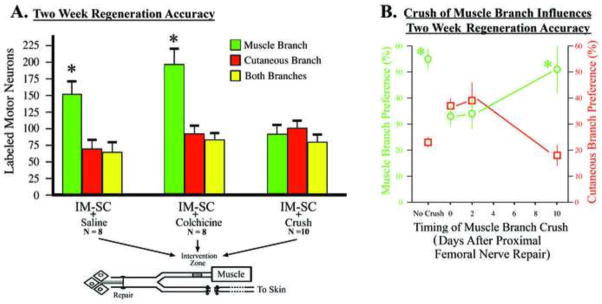Figure 5.

Motor neuron regeneration accuracy is lost by a nerve crush of the terminal muscle branch. A) Animals received the intact-muscle:short-cutaneous (IM-SC) surgical preparation and also received various interventions to the terminal muscle branch during the same surgery (“intervention zone”). Regeneration accuracy was quantified two weeks later as the number of femoral nerve motor neurons that correctly projected back to the original terminal muscle branch versus the inappropriate cutaneous branch. Animals that received colchicine application to the terminal muscle branch, to disrupt retrograde transport in the denervated nerve, displayed robust regeneration accuracy (t=3.45, p=.01) similar to control animals that received saline application (t=3.12, p=.0001). Regeneration accuracy was blocked when animals received a crush of the terminal muscle branch that disrupts both retrograde transport and diffusion in the denervated nerve (t=0.63, p=.56). B) To further investigate the effects of a crush to the terminal muscle branch additional animals received a crush of the terminal muscle branch at various days after the parent femoral nerve repair. The “pathway reinnervation preference” was quantified as described in Methods. When there was no crush of the terminal muscle branch there was a significant muscle branch preference for regenerating motor neurons (t=5.56, p=.001). If the terminal muscle branch was crushed at the same time or 2 days after the parent femoral nerve repair the muscle branch preference was blocked. However, if the terminal muscle branch was crushed 10 days after the femoral nerve repair there was a significant muscle branch preference (t=3.12, p=.02) as was seen with no crush.
